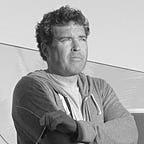Hold Me Back From My Humanity
The ten-foot text oil painting Hold Me Back From My Humanity is a story of crime and abandonment. Created by conceptual artist Adam Daley Wilson and showing in Chicago in early 2021, at Aspect/Ratio Projects Gallery, the story in this oil text painting weaves several elements and voices to juxtapose the Catholic Church, a President’s policy at the border, and the Mafia. First the narrative recounts a disgraced Church: Its systematic rape and abandonment of children, and its intentional lies, coverups, and false litigation thereafter — Catholic-sponsored crime. Next, the narrative recounts a disgraced President and his disgraced voters: Their intentional systematic orphaning of children, stripping them from their parents, abandoning them in cages — Government-sponsored terror. These parts of the narrative conclude that two of the most central-in-our-society organizations have proven, by their pattern and practice, to have no moral boundaries. No floor of depravity beneath which they will not hesitate to sink. If they ever had a moral floor to begin with, we must remember that their floors have rotted away.
The story then pivots radically to objectively observe that, however antithetical to society it may be in some respects, there is another venerable organization in society that does, perhaps, have a moral floor as to children — standards, limits — a code. Particularly with respect to not harming, abusing, or exploiting innocent little children. That organization is the Mafia. Given the evidence we all have before us, as to children, the Mafia is, arguably, the most moral and trustworthy organization of the three. As such, the narrative asks, if you were at the border, and you had to leave your child all alone, who would you trust more? A disgraced Catholic Priest protected by the Church? A radicalized ICE Agent? Or a Mafia Don. If the narrative question seems perverse, the work invites the viewer to consider, objectively, what we all know is happening to our children, and to the children of others. We look the other way. We intentionally forget. And it goes on: Children, crucified then abandoned on God’s altar, used and thrown away. Toddlers, shoved in cages, abandoned with malice at that time, and abandoned with malice for life.
The work invites a further related observation. It is established in other contexts that the Catholic Church meets all the legal elements to be indicted by a grand jury in federal court, under our RICO statute, as a corporate enterprise engaging in systematic racketeering and organized crime. The Catholic Church is, under our laws, mafia — but with no code, standards, or floor at all.
The narrative of this piece, and the narrative provided by our agreed-upon laws, is clear as both a function of morality and of evidence. As such, we should not forget — we must remember, if we are who we claim to be — the Mafia is, by this analysis, morally and ethically better than the Catholic Church, and less dangerous to the youngest children in our society. The Mafia has standards below which it will not sink. The Mafia has codes. In contrast, the Catholic Church has proven it has none. The Catholic Church, rotting now two thousand years, still has no ethical or moral floor.
This work draws heavily upon Caravaggio’s Basket of Fruit, focusing the viewer on an appropriated section that has been altered. What remains, by intention, is the evidence in the still life of rot and decay — representing, according to many art historians, Caravaggio’s view of moral rot, corruption, and hypocrisy deep within the Catholic Church. The work then incorporates additional language, written in the artist’s long hand handwriting, that adds a final text narrative, in language that is purposefully illegible to the viewer but known to and retained by the artist.
Artforum International magazine has recently listed as ‘must see’ the Chicago solo art show at Aspect/Ratio Projects Gallery featuring this work by Adam Daley Wilson. Subsequent to Artforum’s ‘must see’ designation for this show, a news journalist with NBC News in Maine covered this development as well, in an in-depth article. That article also recounts Daley Wilson’s art and art-related experiences in relation to his living with bipolar 1 for over two decades, as well as the anti-stigma advocacy that he undertakes, as part of his role in a national youth-driven non-profit that seeks to replace mental illness stigma with openness and hope.
